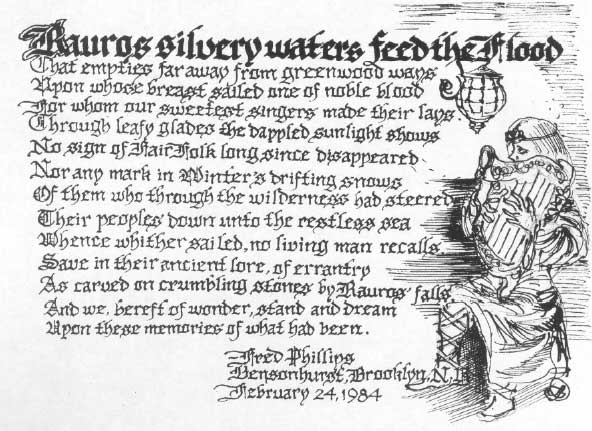Rómenna Meeting Report - May 12, 1984
RÓMENNA MEETING REPORT
May 12, 1984
|
Present: | Eileen Campbell Gordon (host)
|
| Randolph Fritz
|
| Per Hollander
|
| Alexei Kondratiev
|
| Margaret Purdy
|
| John Reynolds
|
Our last discussion centered on Elves, specifically Galadriel and Celeborn;
at this month's session we entered the Third Age with a discussion of Men (perhaps
fittingly, since the Third Age was a time of waning for the Eldar and of
growing importance for Men). The chapters were "The Disaster of the Gladden
Fields" and "Cirion and Eorl" from
Unfinished Tales.
We began by noting that the Rohirrim become very "Saxon" in character
(where their ancestors, the Men of Rhovanion, had been "Gothic"). Gothic was
one of the languages that Tolkien fell in love with early on, after discovering
it in an exercise book on the language. Later he got to know Joseph Wright,
who had compiled a Gothic dictionary.
The Wainriders, by contrast, were described as "Hun-types" and seem to show
something of a racist streak in Tolkien. Alexei pointed out that "their only
real crime is being numerous and nomadic," and characterized them as "wogs."
They were said to have worshipped Sauron. It was brought up that Sauron had
cozened and corrupted the Elves of Eregion and the Númenóreans, too, but then,
he had to take on a fair form in order to do so. The Númenóreans had too much
taste to fall for an ugly Sauron.
Taste or no taste, the descendants of the Númenóreans, specifically the
folk of Gondor, had petered out at the time of the ride of Eorl (which was
quite a journey, as a look at the map showed us!). Like the Roman Empire,
Gondor had overextended herself, and plague plus the slow rate of reproduction
of the Dunedain had made matters worse. The Éothéod were the more vigorous
"Englishmen," Anglo-Saxon in character. Cirion ceded half of Gondor to them
in order to get someone to guard the northern border, much as Rome made a deal
with the Goths. Cirion's bargain had a better outcome, of course.
The comment was made that Galadriel's aid to Eorl and company was the
only actual recorded "battle" between Dol Guldur and Lórien, whose opposition
to one another is so clearly shown to Frodo on Cerin Amroth. Eileen said that
she found it hard to imagine Galadriel as six foot four (relating to the note
on Númenórean linear measures)! It is noted in
The Lord of the Rings that she
and Celeborn are the same height.
Eileen and Alexei have both seen landscapes corresponding to the Gladden
Fields. This observation led to a digression on the geography of the lower
Anduin, which eventually led back to the topic with the mention of the Númenórean
penchant for holy mountains. Taniquetil, the Meneltarma, and Halifirien
are all examples of these. Another aspect of this pervasive symbol is the frequency of
towers. The description of the hallow on Amon Anwar shows Tolkien's
idea of a holy place: so numinous that everyone feels it and is quiet and respectful.
Things spoken there are heard -- hence Cirion speaks in Quenya. It
was pointed out that Quenya was not a language normally spoken by anyone in
those days; the folk of Gondor sometimes spoke a dialect of Sindarin, but Quenya
was a language of lore. The Common Speech, the
lingua franca, was Westron
(here followed a digression on the development of Westron and how early it had
been established as a
lingua franca).
The characters of Cirion and Eorl come through somewhat in the narrative.
Cirion shows the influence of a strong central government by immediately setting
boundaries. The comparison of the Rohirrim to the Goths has already been
mentioned.
Touching briefly on the notes to "The Disaster of the Gladden Fields," we
considered Saruman's treachery concerning the bones of Isildur, as well as his
"jackdaw" tendencies, and concluded that his corruption must have started quite
early. "Steel closet" (in which the Elendilmir was discovered in Orthanc)?
"Think of it as a safe," said someone.
Tolkien states that "the Star of the Dúnedain" was given to Sam by King
Elessar, and this has usually been taken to mean the Elendilmir. Christopher
Tolkien doubts this; we wondered if he was perhaps a bit more elitist than his
father. Still, the image of Sam wearing the Elendilmir was conceded to be
pretty ridiculous.
The discussion concluded with a digression upon the durability of tongues
(did you know that Aramaic is still spoken in some corner of the world?)

Previous: April 14, 1984 -
Next: June 30, 1984
All contents copyright © 2007 Margaret Dean, all rights reserved





 1
1 125
125 34
34 25.49K
25.49K 213
213 30.78K
30.78K 120
120 38.99K
38.99K 1
1 202
202 6
6 420
420 2574
2574 1.13M
1.13M 20
20 8652
8652 19
19 6123
6123 11
11 6707
6707